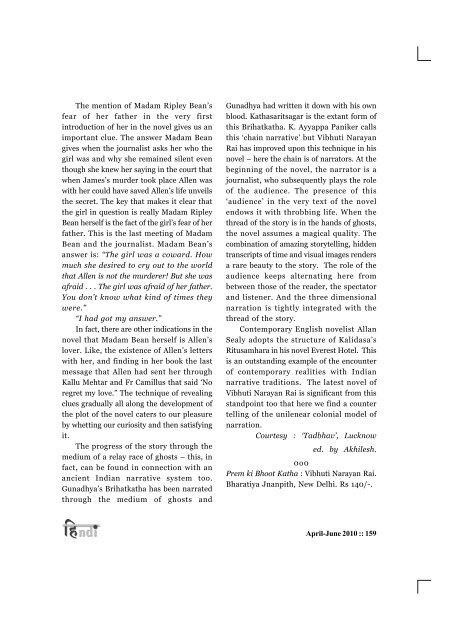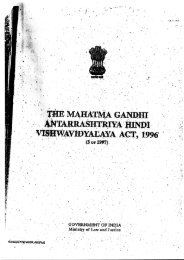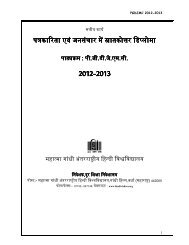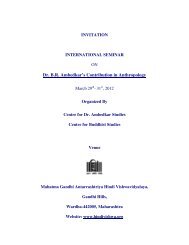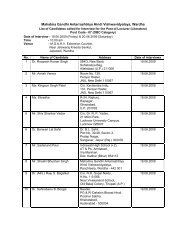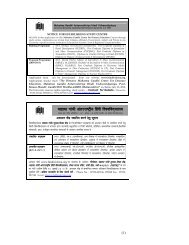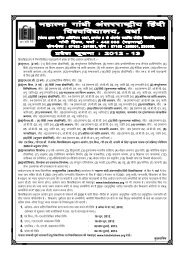Mamta Kalia
Mamta Kalia
Mamta Kalia
Create successful ePaper yourself
Turn your PDF publications into a flip-book with our unique Google optimized e-Paper software.
The mention of Madam Ripley Bean’s<br />
fear of her father in the very first<br />
introduction of her in the novel gives us an<br />
important clue. The answer Madam Bean<br />
gives when the journalist asks her who the<br />
girl was and why she remained silent even<br />
though she knew her saying in the court that<br />
when James’s murder took place Allen was<br />
with her could have saved Allen’s life unveils<br />
the secret. The key that makes it clear that<br />
the girl in question is really Madam Ripley<br />
Bean herself is the fact of the girl’s fear of her<br />
father. This is the last meeting of Madam<br />
Bean and the journalist. Madam Bean’s<br />
answer is: “The girl was a coward. How<br />
much she desired to cry out to the world<br />
that Allen is not the murderer! But she was<br />
afraid . . . The girl was afraid of her father.<br />
You don’t know what kind of times they<br />
were.”<br />
“I had got my answer.”<br />
In fact, there are other indications in the<br />
novel that Madam Bean herself is Allen’s<br />
lover. Like, the existence of Allen’s letters<br />
with her, and finding in her book the last<br />
message that Allen had sent her through<br />
Kallu Mehtar and Fr Camillus that said ‘No<br />
regret my love.” The technique of revealing<br />
clues gradually all along the development of<br />
the plot of the novel caters to our pleasure<br />
by whetting our curiosity and then satisfying<br />
it.<br />
The progress of the story through the<br />
medium of a relay race of ghosts – this, in<br />
fact, can be found in connection with an<br />
ancient Indian narrative system too.<br />
Gunadhya’s Brihatkatha has been narrated<br />
through the medium of ghosts and<br />
Gunadhya had written it down with his own<br />
blood. Kathasaritsagar is the extant form of<br />
this Brihatkatha. K. Ayyappa Paniker calls<br />
this ‘chain narrative’ but Vibhuti Narayan<br />
Rai has improved upon this technique in his<br />
novel – here the chain is of narrators. At the<br />
beginning of the novel, the narrator is a<br />
journalist, who subsequently plays the role<br />
of the audience. The presence of this<br />
‘audience’ in the very text of the novel<br />
endows it with throbbing life. When the<br />
thread of the story is in the hands of ghosts,<br />
the novel assumes a magical quality. The<br />
combination of amazing storytelling, hidden<br />
transcripts of time and visual images renders<br />
a rare beauty to the story. The role of the<br />
audience keeps alternating here from<br />
between those of the reader, the spectator<br />
and listener. And the three dimensional<br />
narration is tightly integrated with the<br />
thread of the story.<br />
Contemporary English novelist Allan<br />
Sealy adopts the structure of Kalidasa’s<br />
Ritusamhara in his novel Everest Hotel. This<br />
is an outstanding example of the encounter<br />
of contemporary realities with Indian<br />
narrative traditions. The latest novel of<br />
Vibhuti Narayan Rai is significant from this<br />
standpoint too that here we find a counter<br />
telling of the unilenear colonial model of<br />
narration.<br />
Courtesy : ‘Tadbhav’, Lucknow<br />
ed. by Akhilesh.<br />
0o0<br />
Prem ki Bhoot Katha : Vibhuti Narayan Rai.<br />
Bharatiya Jnanpith, New Delhi. Rs 140/-.<br />
April-June 2010 :: 159


